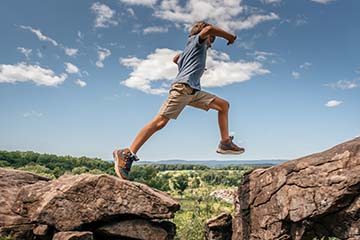Benefits of Encouraging Risk: Beyond the Early Years
- Blog Benefits of Encouraging Risk: Beyond the Early Years
This is part three of a three-part series on risk and risky play. Part one of this series touches on the basics of risky play in early childhood. Part two discusses how to seek out appropriate but challenging play opportunities in public play spaces, including playgrounds and museums. I recently sat down with Cheryl Strayed, the ultimate adventure mama and author of the book Wild: From Lost to Found on the Pacific Crest Trail. I may have fangirled a little, but I also got to ask her how she has been able to foster a sense of adventure, calculated risk, and independence in her two children, now 14 and 15. Strayed related how her children convinced her to let them go paragliding during a family trip to France when they were only eight and nine years old. The clincher was when her son said: "I don't want to be the kind of person who doesn't do things just because they scare me." As a mother, she was blown away by his wisdom, and she came to realize that this was a lesson she had taught her children, bit by bit, since they were tiny.
Proactive Communication as a Teaching Tool
 When I asked Strayed how she managed to impart a sense of bravery and adventure in her children, she emphasized not only parental example but also communication. For instance, when young kids want to learn to ride a skateboard or a scooter, that's the time to talk to them about taking precautions, such as always wearing a helmet. She also said that she thinks ahead and makes a point to initiate discussions that don't necessarily come up organically. Melissa Gula, manager of family and children's programs at Denver Botanic Gardens, agrees. For young children, she gives the example of throwing rocks. When no one is in the line of fire, it's probably OK for a kid to throw small rocks into a stream. Another day, when the sun comes out and all of a sudden every kid in the neighborhood is wading in the stream, it's a different story.
When I asked Strayed how she managed to impart a sense of bravery and adventure in her children, she emphasized not only parental example but also communication. For instance, when young kids want to learn to ride a skateboard or a scooter, that's the time to talk to them about taking precautions, such as always wearing a helmet. She also said that she thinks ahead and makes a point to initiate discussions that don't necessarily come up organically. Melissa Gula, manager of family and children's programs at Denver Botanic Gardens, agrees. For young children, she gives the example of throwing rocks. When no one is in the line of fire, it's probably OK for a kid to throw small rocks into a stream. Another day, when the sun comes out and all of a sudden every kid in the neighborhood is wading in the stream, it's a different story.
Collaborative Boundary-setting to Teach Situational Awareness
Instead of abruptly changing the rules ("No throwing rocks today"), try asking the child whether it would be a good idea to throw rocks today, and why or why not. Bonus points if you remember to have this conversation before the rock-throwing starts. Even very young children can quickly see that the circumstances have changed and that now, people might get hurt. What's immediately apparent to you may not be obvious someone with so little life experience, though, which is why it's good for parents to initiate the discussion ahead of time. The goal of this type of conversation is to get kids thinking about what could happen as well as what steps they can take to protect themselves and other people. This helps children develop good judgment and learn to assess risk in various situations. From there, they will (eventually) be able to identify when it's a good time to "be brave" and push out of their comfort zones and when it's a good time to pass on an activity. When your communication about risky situations stops at "be careful" or "get down before you hurt yourself," you're missing an opportunity. This kind of absolute limit (when there's no immediate danger) doesn't help children flex their good judgment muscles.
Healthy Risk-taking in Middle Childhood and Beyond
So, what's the long-term outcome of all of this risky play guiding and communicating in early childhood? Researchers tell us that appropriate opportunities for play give children space to develop "physical competence and enjoyment of the outdoors, understand and make sense of their world, [and] interact with others," among other benefits. But what does that look like in the real world? For Strayed's children, now in their teens, growing up with room to take risks has translated into knowing themselves better and having more confidence to pursue their interests and passions. She told me that her son, who was in 9th grade at the time, jumped at the chance to go across the country for a week-long creative writing intensive on a college campus he had never visited before. What struck her was the immediacy of his decision and that, unlike a lot of kids his age, he didn't say, "I'll go if I can find a friend to go with me." She's convinced that his choice wasn't impulsive, either. He wanted to go because he knows himself and his interests, and he doesn't hesitate to try new things just because they're new and unknown. ******************* Raising brave, adventurous children is easier in the company of other families on the same path. Connect with local families and caregivers who are also navigating the outdoors with young children. Learn more about Hike it Baby membership options and join our supportive community today!
About The Author
 Sarita Li Johnson believes in unstructured play, inquiry-based learning, and road tripping as much as possible. You will often find her and her two roadschooling children somewhere between Denver, Colorado, and Morro Bay, California. Follow along on Instagram @thelandlockedmama. The opinions expressed in this blog are those of the author and not necessarily the opinions, thoughts, or recommendations of Hike it Baby. Image courtesy of Jessica Human.
Sarita Li Johnson believes in unstructured play, inquiry-based learning, and road tripping as much as possible. You will often find her and her two roadschooling children somewhere between Denver, Colorado, and Morro Bay, California. Follow along on Instagram @thelandlockedmama. The opinions expressed in this blog are those of the author and not necessarily the opinions, thoughts, or recommendations of Hike it Baby. Image courtesy of Jessica Human.
About Hike it Baby
Editors Note:
Related Content




Comments